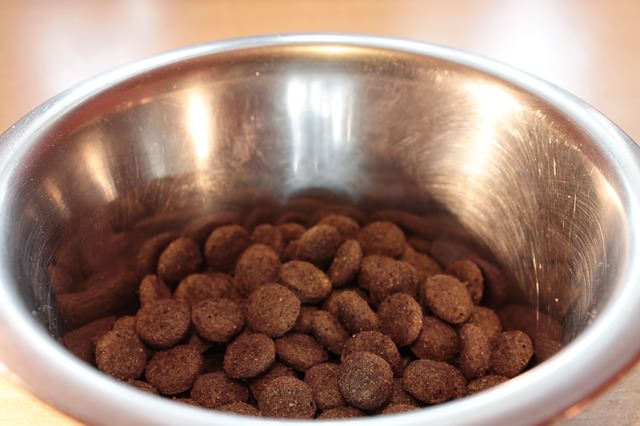It should come as no surprise to our readers that pet food companies are not the most trusted institutions in the world.
In a recent survey performed by the research team here at iHeartDogs, we found that only 6.9% of respondents trust that major market pet food brands are delivering quality, safe pet food products for their dogs. In addition, only 17% of consumers think that pet food manufacturers do a good job of educating consumers about pet nutrition.
While there are many lies and half-truths perpetuated by individual dog food companies, we’d like to narrow in on three in particular that we believe are rampant across nearly all manufacturers of dry dog food.
Lie #1: How Much Protein Their Product Really Contains

The ingredients on a dog food label are listed by weight, from most to least. Meats have a moisture content of around 75% when added to pet food. However, after a food is processed and dried, the meat will have a moisture content of less than 10 percent! In other words, the chicken or beef loses up to 70% of its weight after it’s manufactured into kibble.
Most dry dog foods can have a meat source listed as the first ingredient, but still contain very low amounts of high-quality protein. Instead, they use fillers like corn, soy, or wheat to bulk up their product with low-cost ingredients that are not biologically suitable for a dog.
The lack of protein in dry dog food is one of the major reasons so many dog owners are switching to raw diets, or at least starting with adding raw protein toppers or “mixers” into their dog’s kibble.
Also, be careful of ingredient splitting, another sneaky tactic manufacturers use to disguise less desirable ingredients. Ingredient splitting consists of breaking an ingredient into several different smaller ingredients and listing them individually.
For example, a product list could contain chicken, ground corn, corn gluten, and corn bran. If we were to group all of the corn ingredients together as one, they would substantially outweigh the amount of chicken. By splitting them up, manufacturers are allowed to show chicken as the first ingredient.
Lie #2: Implying Their Product Contains Sufficient Levels of Glucosamine

Most of us understand the importance of the joint-enhancing nutrient known as glucosamine. Not only is it important for aging dogs, but humans as well.
Many well-marketed pet food brands include glucosamine in their product. In fact, many highly specialized, expensive prescription brands that focus on senior dogs brag about it on their labels. “Contains glucosamine, which naturally helps alleviate joint pain and promote mobility!” Sounds great, right?
But do these claims add up? Is the amount of glucosamine added sufficient to actually make a difference in your dog’s joint health?
For a dog in need of glucosamine supplementation (which is nearly all dogs over 7, and some breeds as early as 12 months), most veterinarians recommend at least 1000 mg a day. Knowing this, how much glucosamine does the typical “joint support” kibble contain?
According to research done by Rodney Habib of Planet Paws, the typical dog food that markets itself towards dogs with joint problems would require serving your dog 18-29 cups of kibble in order for them to obtain the recommended 1000 mg of glucosamine!
No sane pet parent will give their dog this much kibble, regardless of their size and weight. However, the implication of many joint care or senior-focused dog food brands is that their product contains enough glucosamine to make a difference in your dog’s mobility. The sad truth is it does not, and further supplementation would be required to obtain the recommended amount.
RELATED: At What Age Should I Begin Giving My Dog Glucosamine?
Lie #3 – Adding Omega-3 Fatty Acids, Fully Knowing the Manufacturing Process Will Destroy Them

Omega-3 Fatty Acids, also known as essential fatty acids, have myriad health benefits for people and pets. So much so, they have become a magnet for pet food marketers to use when promoting their products.
Many premium dog food brands include a source of Omega-3’s in their formula. The problem, however, is the way in which dry dog food is manufactured.
Take a look at the ghastly device below, called an extruder. Used in dry dog food manufacturing, a mixture is forced through the extruder at extremely high temperatures. The steam then cooks the mixture and “extrudes” it through a small opening, forming it into the well-known kibble shapes we see in the dog food bag.

Omega-3’s are highly susceptible to heat and tend to break down and become useless during a high-heat manufacturing method. Is it any wonder how any ingredient survives this, let alone fragile omega-3 fatty acids?
If, by some miracle, the omega-3 fatty acids survive the high heat of extrusion, their next trial comes from the risk of spoiling. Once omega-3 fatty acids come in contact with oxygen and light, they have a strong tendency to become rancid quickly.
From the very moment we open that bag of dog food kibble, the timer starts ticking on its life. Keeping your food in an airtight container helps. Still, it’s impossible to prevent the fatty acids from coming into contact with oxygen and light, which can lead to spoiling over time.
Again, we find that the marketing of pet food brands implies your dog’s nutrition is being met, but that is not the case. Omega-3’s, in particular, are incredibly vital to your dog’s immune health, skin and coat, brain health, and so much more. It is often recommended that if you only give your dog one supplement, to make it an Omega-3. If you do not use a commercial supplement, add a fresh fish source to your dog’s diet.
If you’re looking to cut to the truth and choose a good dog food brand for your pup, see our list of Best Dog Foods.
Share Your Thoughts in the Comments!
We want to hear from you about your experience making pet food choices for your dog. What do you currently feed and why? What have you learned through the process of selecting that food?
 Toledo, United States.
Toledo, United States.